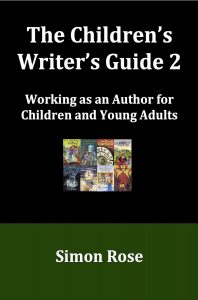I’m pleased to welcome back Simon Rose, author of fifteen novels and many nonfiction books for children and young adults. He’s also the author of eight guides for aspiring authors and has just released the second installment of The Children’s Writer’s Guide.

So what’s this latest book all about?
The Children’s Writer’s Guide 2 is ideal for writers not just of books for children and young adults, but also features information that’s applicable to writers in all genres. The first installment of The Children’s Writer’s Guide has a wealth of tips and advice, including suggestions regarding how to get started as a writer, dealing with writer’s block, conducting research, choosing appropriate names for your characters, the editing and revision process, as well as the world of marketing and promotion.
This second book further explores the writing process, examining topics such as developing memorable characters, creating effective dialogue, the importance of book covers, the value of blogging, age levels and appropriate content for books for children and young adults, networking, and the process of submitting your work to publishing houses. In combination with The Children’s Writer’s Guide, this second book provides invaluable advice and support for both established and aspiring authors of books for children and young adults.
What inspired you to write this book?
The first instalment of the book came out a few years ago and at the time I had some material left over that didn’t quite fit. I considered writing a second part to the guide, but didn’t have anything else to add at the time and as with many other writers, other projects took priority. However, I did add sections when I had time and finally late last year I had enough to produce the second book.
Have you written and published other guides for writers?
Yes, in total I’ve written and published eight of these types of books. In addition to the two guides for children’s authors, there’s The Time Traveler’s Guide, which examines the writing of time travel stories and historical fiction, The Working Writer’s Guide, that explores the many ways that people can try to make a living as a writer, and The Social Media Writer’s Guide, which features tips and advice about writing online content for websites and social media. Where Do Ideas Come From? is all about creating workshops and presentations based on your books. Exploring the Fantasy Realm and School and Library Visits for Authors and Illustrators are very small books and the material also appears in the first part of The Children’s Writer’s Guide.
Is it important for aspiring authors to read books like this?
Yes, I think so. You obviously need an idea before you can start writing any book, whether it’s fiction or nonfiction and are largely on your own during the writing process. However, it’s always good to conduct research and seek out information that might help you along your journey and both parts of The Children’s Writer’s Guide are very helpful for writers, and not just those writing for children and young adults. Much of the information in both books is very much applicable to writers in all genres, whether for younger readers or for adults.
Where can people purc
hase your book?
The Children’s Writer’s Guide 2 available as a paperback on Amazon and as an ebook on Amazon, Kobo, iBooks, Barnes and Noble, and Smashwords. The ebooks are available in ePub, Kindle, and pdf formats.
Ebook Amazon Kobo Smashwords Barnes and Noble iBooks
Paperback Amazon Barnes and Noble
The Children’s Writer’s Guide is also available in all formats at these locations.
Where can people find out more about you and your books?
You can learn more on my website at www.simon-rose.com or online at the following social media sites:
